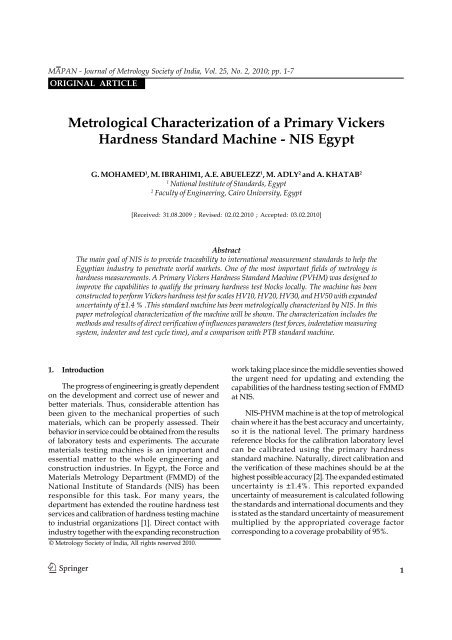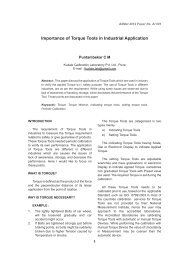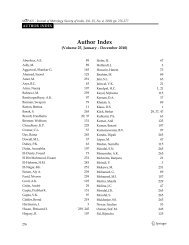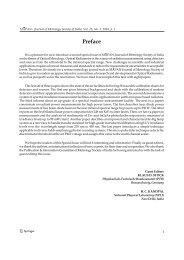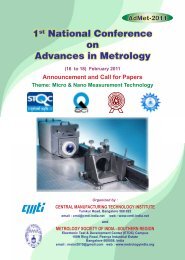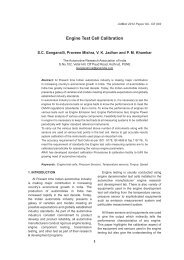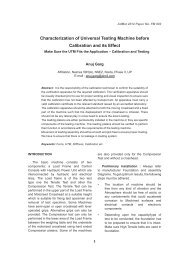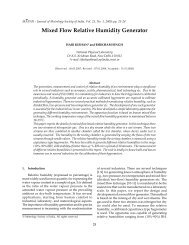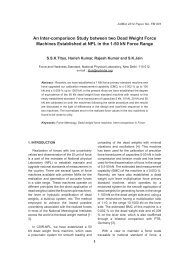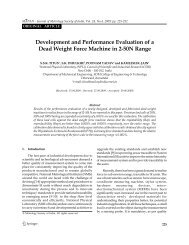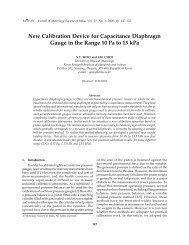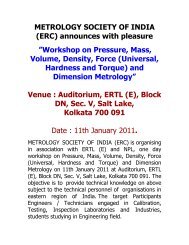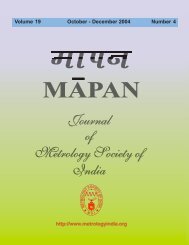Metrological Characterization of a Primary Vickers Hardness ...
Metrological Characterization of a Primary Vickers Hardness ...
Metrological Characterization of a Primary Vickers Hardness ...
Create successful ePaper yourself
Turn your PDF publications into a flip-book with our unique Google optimized e-Paper software.
MAPAN <strong>Metrological</strong> - Journal <strong>of</strong> Metrology <strong>Characterization</strong> Society <strong>of</strong> a India, <strong>Primary</strong> Vol. <strong>Vickers</strong> 25, No. <strong>Hardness</strong> 2, 2010; pp. Standard 1-7 Machine - NIS EgyptORIGINAL ARTICLE<strong>Metrological</strong> <strong>Characterization</strong> <strong>of</strong> a <strong>Primary</strong> <strong>Vickers</strong><strong>Hardness</strong> Standard Machine - NIS EgyptG. MOHAMED 1 , M. IBRAHIM1, A.E. ABUELEZZ 1 , M. ADLY 2 and A. KHATAB 21National Institute <strong>of</strong> Standards, Egypt2Faculty <strong>of</strong> Engineering, Cairo University, Egypt[Received: 31.08.2009 ; Revised: 02.02.2010 ; Accepted: 03.02.2010]AbstractThe main goal <strong>of</strong> NIS is to provide traceability to international measurement standards to help theEgyptian industry to penetrate world markets. One <strong>of</strong> the most important fields <strong>of</strong> metrology ishardness measurements. A <strong>Primary</strong> <strong>Vickers</strong> <strong>Hardness</strong> Standard Machine (PVHM) was designed toimprove the capabilities to qualify the primary hardness test blocks locally. The machine has beenconstructed to perform <strong>Vickers</strong> hardness test for scales HV10, HV20, HV30, and HV50 with expandeduncertainty <strong>of</strong> ±1.4 % .This standard machine has been metrologically characterized by NIS. In thispaper metrological characterization <strong>of</strong> the machine will be shown. The characterization includes themethods and results <strong>of</strong> direct verification <strong>of</strong> influences parameters (test forces, indentation measuringsystem, indenter and test cycle time), and a comparison with PTB standard machine.1. IntroductionThe progress <strong>of</strong> engineering is greatly dependenton the development and correct use <strong>of</strong> newer andbetter materials. Thus, considerable attention hasbeen given to the mechanical properties <strong>of</strong> suchmaterials, which can be properly assessed. Theirbehavior in service could be obtained from the results<strong>of</strong> laboratory tests and experiments. The accuratematerials testing machines is an important andessential matter to the whole engineering andconstruction industries. In Egypt, the Force andMaterials Metrology Department (FMMD) <strong>of</strong> theNational Institute <strong>of</strong> Standards (NIS) has beenresponsible for this task. For many years, thedepartment has extended the routine hardness testservices and calibration <strong>of</strong> hardness testing machineto industrial organizations [1]. Direct contact withindustry together with the expanding reconstruction© Metrology Society <strong>of</strong> India, All rights reserved 2010.work taking place since the middle seventies showedthe urgent need for updating and extending thecapabilities <strong>of</strong> the hardness testing section <strong>of</strong> FMMDat NIS.NIS-PHVM machine is at the top <strong>of</strong> metrologicalchain where it has the best accuracy and uncertainty,so it is the national level. The primary hardnessreference blocks for the calibration laboratory levelcan be calibrated using the primary hardnessstandard machine. Naturally, direct calibration andthe verification <strong>of</strong> these machines should be at thehighest possible accuracy [2]. The expanded estimateduncertainty is ±1.4%. This reported expandeduncertainty <strong>of</strong> measurement is calculated followingthe standards and international documents and theyis stated as the standard uncertainty <strong>of</strong> measurementmultiplied by the appropriated coverage factorcorresponding to a coverage probability <strong>of</strong> 95%.1
G. Mohamed, M. Ibrahim, A.E. Abuelezz, M. Adly and A. Khatab2. NIS <strong>Primary</strong> <strong>Vickers</strong> <strong>Hardness</strong> StandardMachineThe PHVM was designed to achieve thedevelopment and modernization <strong>of</strong> the FMMD <strong>of</strong> theNIS. Intentions are to achieve two main features. Thefirst feature concerned with constructing primary<strong>Vickers</strong> standard machine to cover a range from HV10to HV50 through HV (10, 20, 30 and 50) which are themost common in <strong>Vickers</strong> hardness scale to improvethe calibration capabilities <strong>of</strong> FMMD for hardness.The second feature is the ability to develop themachine to cover the range <strong>of</strong> <strong>Vickers</strong> until HV120and also to improve the function <strong>of</strong> the machine in thefuture [1].The metrological characterization consists <strong>of</strong> thedirect verification <strong>of</strong> the machine and a comparisonwith PTB primary hardness standard machine; in thedirect verification, the main verified parameters arethe forces generated by the PVHM, the geometry <strong>of</strong>indenters and indentation measuring system.2.1 The Main Structure <strong>of</strong> the MachineThe machine consists <strong>of</strong> dead weights for thegeneration <strong>of</strong> the test forces which can be selectedmanually, a very flexible control unit that permits toset all the most important parameters involved in thetest cycle (times and velocities) and separated imageprocessing system measurements [1].The main structure <strong>of</strong> the mechanical system <strong>of</strong>the machine includes;i) Load generation system (E): This system utilizedto generate the required load values to obtain thedesired thought four standard test loads HV (10,20, 30 and 50). This system includes the indenter'sframe and the weights.ii) Load and unload system (G): Testing weightsselection is designed to be manual. The mainparameter which aimed to be controlled is thetest time so it should be automated. The selection<strong>of</strong> the weights can be performed manually usinga specified tools fixed on two column.iii) Machine fixed frame (M): It's a frame used tosupport the machine. It should be rigid enough toresist the buckling or deflection due to the appliedcompressive load the main fixed frame includesFig. 1. Photograph for the standardMGER$Fig. 2. Overall construction <strong>of</strong> the standard machine2
<strong>Metrological</strong> <strong>Characterization</strong> <strong>of</strong> a <strong>Primary</strong> <strong>Vickers</strong> <strong>Hardness</strong> Standard Machine - NIS Egypttwo platens connected by four tie bars and othertwo bars inserted to carry the pins used to selectthe desired weights manually. The fixed frameshould be adjusted by leveling nuts utilized toadjust the machine vertically (Figs. 1 and 2)3. Direct VerificationThe <strong>Vickers</strong> hardness value obtained by dividingthe test force by the contact area <strong>of</strong> indentation asreported earlier [3];á2× F × Sin( )FHV = 0.102× 2 = 0.1891 ×2 2ddSo it was noted that the main parameters thataffects the hardness test results could be the testingforce (F), the angle between the opposite faces at thevertex <strong>of</strong> pyramidal indenter (á), and the indentiondiagonal (d). These parameters can be classified intothree main sources;• Test force• Indenter geometry• Indentation measuring system.• Test cycle time which has been calibrated withstop watch.The relative uncertainty U t<strong>of</strong> the test cycle time is± 0.1 %.3.1 Force(1)The NIS PVHM generates forces by means <strong>of</strong> deadweights in the range from HV10 up to HV50. Toperform the verification, the anvil <strong>of</strong> PHVMs has beenremoved to create room to lodge the load cells.Two different load cells with an adequateuncertainty (class 00 <strong>of</strong> ISO 376:2005) have been usedfor the direct verification <strong>of</strong> the forces generated bythe PHVMs (Fig. 3). These load cells have beencalibrated at NIS before the verification [3] .The results<strong>of</strong> test force verification are shown in Fig. 4 andTable 1.whereuFHYTMSFi1= ×F nHere S Fiis the standard deviation <strong>of</strong> the test-forceindication values in the i-th height position.The combined relative standard uncertainty (u F) <strong>of</strong>the test force calibration is calculated as follows;u u 2 u2F FRS FHTMwhere u FRSis the relative uncertainty <strong>of</strong> measurement<strong>of</strong> the force transducer (from calibration certificateIncluding temperature dependence long-termstability, and interpolation deviation (± 0.05%);u FHTMis the relative standard uncertainty <strong>of</strong> the testforce generated by the hardness testing machine.The relative deviation <strong>of</strong> force is calculated fromthe following equation;F FFRSrelF(2)(3)(4)Fig. 3. A photograph <strong>of</strong> the machine calibration using load cell3
G. Mohamed, M. Ibrahim, A.E. Abuelezz, M. Adly and A. KhatabFig. 4. The test force accuracy calibration <strong>of</strong> the standard machineTable 1Test force calibration resultsNominal Series1 Series 2 Series 3 Mean Relativeu u FHTMload F1 F2 F3 F divisionF RSÄF relN N N N N % %98.07 98.18 98.15 98.01 98.11 -0.044 0.044196.1 196.15 196.19 196.07 196.13 0.002 0.015294.2 294.10 293.70 294.20 294.00 0.071 0.042490.3 490.13 490.10 490.15 490.13 0.045 0.002PVHM force calibration shows that the maximumrelative deviation <strong>of</strong> force is ± 0.07% and uncertaintyu F<strong>of</strong> ± 0.16%.3.2 <strong>Vickers</strong> Diamond Indenter<strong>Vickers</strong> diamond indenters have been calibratedby a DKD laboratory. All results fulfill the ISOspecifications [4]. The specification <strong>of</strong> the indentersused can be summarized as follows.• The vertex <strong>of</strong> the pyramidal indenter is 136 ± 0.1º,• The indenter should be certified and the certificatemust include the value <strong>of</strong> standard uncertainty(U Ind) not more than ± 0.1 %• The angle between the axis <strong>of</strong> the diamondpyramid and the axis <strong>of</strong> the indenter-holder(normal to the seating surface) should be less than0.3°.4
<strong>Metrological</strong> <strong>Characterization</strong> <strong>of</strong> a <strong>Primary</strong> <strong>Vickers</strong> <strong>Hardness</strong> Standard Machine - NIS Egypt3.3 Indentation Measuring System VerificationCamera Control Drive (CCD) image processingsystem was used for indentation measurements. Thissystem is provided with magnification lens and CCDcamera interfaced with image processing s<strong>of</strong>tware(Fig. 5). The results <strong>of</strong> Indentation measuring systemverification are shown in Table 2.uLHYTMsLi1= ×L n(5)where s Liis the standard deviation <strong>of</strong> the lengthindication values for the i-th indication value <strong>of</strong> theobject micrometer.The combined relative standard uncertainty <strong>of</strong> thereference instrument for the measuring system iscalculated as follows [3]:u = u + u + u2 2L LRS ms LHTM(6)where u LRSis the relative uncertainty <strong>of</strong> measurement<strong>of</strong> the object micrometer (reference standard) from thecalibration certificate (± 0.3 %), u msis the relativeuncertainty <strong>of</strong> measurement due to the resolution <strong>of</strong>the measuring system, and u LHTMis the relativestandard uncertainty <strong>of</strong> measurement <strong>of</strong> the hardnesstesting machine.The relative deviation <strong>of</strong> indentation measuringsystem is calculated from the following equation;RS-Ä Lrel= L L(7)LThe calibration <strong>of</strong> image processing system isshowing uncertainty <strong>of</strong> ± 0.62 %3.4 The Expanded Uncertainty <strong>of</strong> the Machine byDirect VerificationThe combined uncertainty <strong>of</strong> the standardmachine u c[5] is then estimated as;2 2 2 2u = u + u + u + u = 0.7% (8)cF Ind L tThe relative expected uncertainty <strong>of</strong> the primary<strong>Vickers</strong> hardness testing U expcan be calculated fromthe following equation.U 2expexpu cU 2 0.7 1.4 %The relative expanded uncertainty <strong>of</strong> the primary<strong>Vickers</strong> hardness testing machine which had beenevaluated from direct verification was found to be ±1.4 %.(9)Fig. 5. A photograph <strong>of</strong> the indentation measuring system5
G. Mohamed, M. Ibrahim, A.E. Abuelezz, M. Adly and A. KhatabTable 2Measuring system uncertaintyNominal Series1 Series 2 Series 3 Mean Relative u FHTMu MSLRS F1 F2 F3 L divisionÄL relmm mm mm mm mm % % %0.050 0.0499 0.05000 0.0499 0.049933 -0.133 0.055 0.030.100 0.0999 0.09999 0.0999 0.099900 -0.100 0.000 0.030.150 0.1499 0.14995 0.14995 0.149950 -0.033 0.000 0.030.200 0.1999 0.19995 0.19997 0.199940 -0.030 0.009 0.030.250 0.2499 0.24993 0.24995 0.249943 -0.023 0.0023 0.030.300 0.2999 0.29997 0.29996 0.299970 -0.010 0.0016 0.030.350 0.3499 0.34996 0.34995 0.349953 -0.013 0.001 0.034. ComparisonThe machine was verified to ensure itsperformance using standard hardness test blockswhich have been tested on PTB primary <strong>Vickers</strong>hardness testing machine. Two standard blocks wereused for this purpose. The applied load values were30 kgf and 10 kgf with hardness values <strong>of</strong> 832 HVand 394 HV and with uncertainty <strong>of</strong> ± 3.17 HV and ±2.33 HV respectively. Five indentations were done oneach <strong>of</strong> them and <strong>Vickers</strong> hardness values werecalculated. Finally, the coefficient E n[5] , whichevaluates the agreement between the measurementdeviations found in the comparison and theuncertainties stated by the participant it can becalculated from the following equation,XlabXref2U 2Uwhere X labis the measurement result <strong>of</strong> the establishedmachine, X refis the reference value calculated by theweighed mean value, U labis the uncertainty stated bythe established machine and U refis the uncertainty <strong>of</strong>X refcalculated by the uncertainty <strong>of</strong> the weighed meanvalue. For the reference values only the measurementresults with E 1 are considered in Table 5.n5. ConclusionTable 3The results <strong>of</strong> testing 394 HV hardness test block• A new <strong>Primary</strong> <strong>Vickers</strong> hardness standard machinehas been constructed to improve NIS hardnessmeasurements capabilities.Test block 394 HV 10 394 U ref=±2.3HV10R1 R2 R3 R4 R5 AverageLH (mm) 0.218 0.212 0.218 0.214 0.219 0.216LV (mm) 0.217 0.217 0.213 0.218 0.216 0.216Mean 0.218 0.15 0.216 0.216 0.218 0.216F(N) 98,07 98,07 98,07 98,07 98,07 98,07HV 392 403 399 397 392 397Error % -0.53 2.22 1.31 0.85 -0.53 0.66Enlabref(10)6
<strong>Metrological</strong> <strong>Characterization</strong> <strong>of</strong> a <strong>Primary</strong> <strong>Vickers</strong> <strong>Hardness</strong> Standard Machine - NIS EgyptTable 4The results <strong>of</strong> testing 832 HV hardness test blockTest block 832 HV 10 832 U ref=± 3.2 HV 30R1 R2 R3 R4 R5 AverageLH (mm) 0.258 0.259 0.258 0.259 0.257 0.258LV (mm) 0.256 0.257 0.255 0.258 0.254 0.256Mean 0.257 0.258 0.256 0.259 0.256 0.257F(N) 294.2 294.2 294.2 294.2 294.2 294.2HV 842 836 845 832 852 841Error % 1.20 0.43 1.58 0.04 2.35 1.12Table 5The calculated values <strong>of</strong> E nTest blocks X labX refU labU refE n(HV) (HV)394 HV10 397 394 5.52 2.3 0.51832 HV 30 841 832 11.7 3.2 0.75• The direct verification <strong>of</strong> the constructed primary<strong>Vickers</strong> hardness testing machine shows that theexpanded uncertainty is ± 1.4 %.• the normalized error (E n) value is showing a goodagreement between the measurements carried outon the PTB primary <strong>Vickers</strong> hardness testingmachine and the measurements carried out onthe NIS primary <strong>Vickers</strong> hardness testingMachine,AcknowledgementThe authors are thankful to Dr. G. Aggag, Head,Force and Material Metrology Department, NIS, Egypt,for his valuable cooperation and help. Thanks are alsodue to Dr. K. Herrmann, PTB, Germany and Dr .M.Amer, NIS, Egypt for valuable suggestions andremarks.References[1] G. Mohamed, M. Ibrahim, A. Abu El-Ezzand A. Khatab, Proposed Design for<strong>Primary</strong> <strong>Vickers</strong> <strong>Hardness</strong> StandardMachine. 1st Arab Conference onCalibration and Measurements November,Cairo, Egypt, (2007) .[2] EA-10/16, EA Guidelines on the Estimation<strong>of</strong> Uncertainty in <strong>Hardness</strong>Measure-ments., European Co-operation.[3] ISO 6507-2: Metallic Materials-<strong>Vickers</strong><strong>Hardness</strong> Test-Part 2: Verification andCalibration <strong>of</strong> the Testing Machine, (2005).[4] ISO 6507-3: Metallic Materials - <strong>Vickers</strong><strong>Hardness</strong> Test - Part 3: Calibration <strong>of</strong>Reference Test Blocks, (2005).[5] K. Herrmann, Guidelines for theEvaluation <strong>of</strong> the Uncertainty <strong>of</strong> <strong>Hardness</strong>Measurements, Physikalisch-TechnischeBundesanstalt Bundesallee [PTB]Braunschweig, Germany, MAPAN -Journal <strong>of</strong> Metrology Society <strong>of</strong> India, 20(2005) 5-13.7


